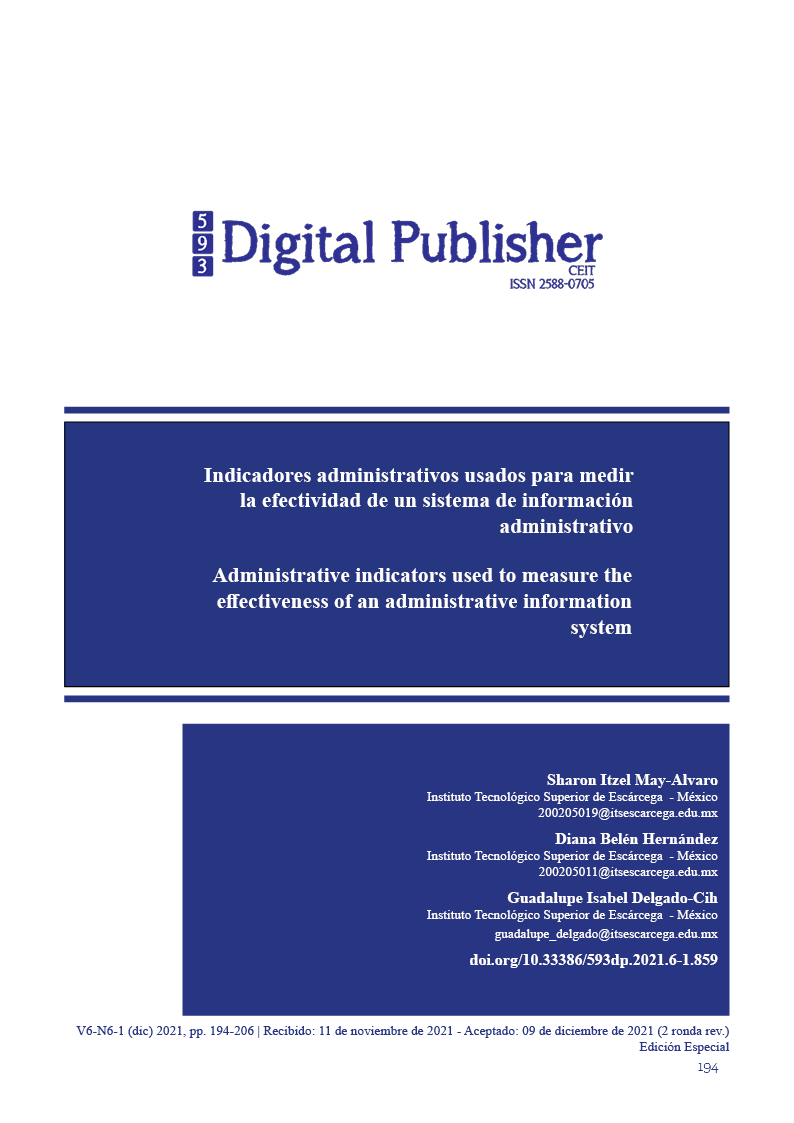Administrative indicators used to measure the effectiveness of an administrative information system
Main Article Content
Abstract
Companies sometimes do not know how to measure the information system they use, it is because of them that management indicators are important, which are an indispensable tool to measure the achievement of organizational goals. The indicators can be of quantitative or qualitative variables, which allow to observe the changes and trends of the objectives or phenomena observed and, in this way, ensure that the tasks carried out are carried out according to their objectives. This document aims to know the management indicators used by organizations to measure their effectiveness. This research is documentary with a qualitative approach why it is carried out with the aim of collecting information on the administrative indicators used to measure the effectiveness of an information system, in this way help to expand knowledge, and make known the opinion of different researchers, and that these can be analyzed in detail. The most commonly used indicators can be presented in three categories: effectiveness, efficiency and effectiveness. The Spanish Association of Accounting and Administration mentions that indicators can be classified according to their nature, by the object and by the scope of action.
Downloads
Article Details

This work is licensed under a Creative Commons Attribution-NonCommercial-ShareAlike 4.0 International License.
1. Derechos de autor
Las obras que se publican en 593 Digital Publisher CEIT están sujetas a los siguientes términos:
1.1. 593 Digital Publisher CEIT, conserva los derechos patrimoniales (copyright) de las obras publicadas, favorece y permite la reutilización de las mismas bajo la licencia Licencia Creative Commons 4.0 de Reconocimiento-NoComercial-CompartirIgual 4.0, por lo cual se pueden copiar, usar, difundir, transmitir y exponer públicamente, siempre que:
1.1.a. Se cite la autoría y fuente original de su publicación (revista, editorial, URL).
1.1.b. No se usen para fines comerciales u onerosos.
1.1.c. Se mencione la existencia y especificaciones de esta licencia de uso.
References
Andreu, Richart y Valor. (1991). Estrategia y sistemas de información. Madrid: McGraw-Hill, Madrid.
Armijo, M. (2011). Planificación estrategica e indicadores de desempeño. Comisión Económica para América Latina y el Caribe. Santiago de Chile.
Asociación Española de Contabilidad y Administración. (1997). Indicadores de Gestión para las Entidades Públicas.
Bahamón, J. H. (2006). Construcción de indicadores de gestión bajo el enfoque de sistemas. Sistemas y Telemática. Obtenido de https://www.icesi.edu.co/revistas/index.php/sistemas_telematica/article/download/1080/1101/
Beltrán, J. (1999). Indicadores de Gestión, Herramientas para lograr la competitividad. Bogotá, Colombia.: Primera Edición. 3R Editores.
Bermúdez, R. (1998). Los indicadores de Gestión Organizacional. Colombia. Obtenido de https://gc.scalahed.com/recursos/files/r161r/w21929w/U4S11L1.pdf
Bonnefoy y Armijo. (2005). Indicadores de desempeño en el sector público. Obtenido de http://repositorio.cepal.org/bitstream/handle/11362/5611/S05900_es.pdf;jsessionid=53AF2991113
Brusca, I. (1995). Nueva Perspectiva de los Informes Financieros en Contabilidad Pública: Indicadores de Gestión. Revista de contabilidad. Obtenido de https://revistas.um.es/rcsar/article/view/384791
Chiavenato, I. (2000). Administración de recursos humanos. Colombia: McGraw.
Covey, S. (1997). Los 7 hábtos de la gente altamente efectiva. Estados Unidos: Paidós.
Deming, E. (1982). Out of the crisis. Cambridge: https://publicaciones.eafit.edu.co/index.php/revista-universidad-eafit/article/download/1104/996/.
Fischer y Espejo. (2004). Mercadotecnia. McGraw Hill.
Jacobs, C. A. (2004). Administración de producción . Mexico: McGraw Hill.
Pérez , F. (2004). Gestión por procesos. Madrid: ESIC Editorial.
Pérez Carballo, V. (2006). Control de la gestión empresarial. Madrid: Sexta edición. Madrid: Libros Profesionales de Empresa/ ESIC Editorial.
Sandhusen, R. (2002). Mercadotecnia . Continental .
Senn, J. (1990). Sistemas de información para la administración. México: Grupo Editorial Iberoamérica.
Velásquez , C. (2003). Modelo de Gestión de Operaciones para Pymes innovadoras. Revista de Escuela de Administración de Negocios. Obtenido de http://journal.ean.edu.co/index.php/Revista/article/view/234/227.




